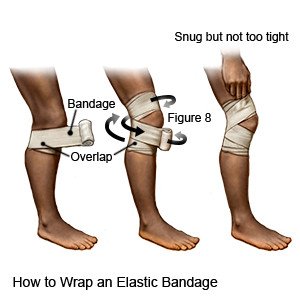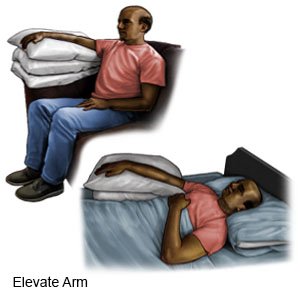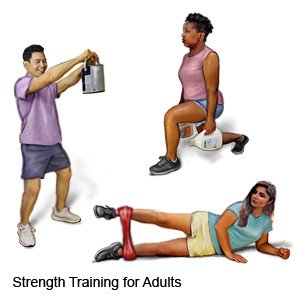Elbow Strain
Medically reviewed by Drugs.com. Last updated on Aug 4, 2025.
AMBULATORY CARE:
An elbow strain
is a twist, pull, or tear of a muscle or tendon. A tendon is a strong elastic tissue that connects a muscle to a bone.
Signs and symptoms of an elbow strain
may not start when the injury happens. You may have one or more of the following:
- Pain or swelling in or around your elbow
- Bruised skin over the injured area
- Sore or weak muscles
- Muscle cramps or spasms
- Crepitus (crackling sound or grating feeling) when you move your muscle
Seek care immediately if:
- The skin of your injured arm looks bluish or pale (less color than normal).
- You have new or increased numbness in your injured arm.
Call your doctor if:
- You have increased swelling and pain in your elbow.
- You have new or increased stiffness or trouble moving your injured arm.
- You have questions or concerns about your condition or care.
Treatment
may include any of the following:
- Medicines:
- NSAIDs , such as ibuprofen, help decrease swelling, pain, and fever. NSAIDs can cause stomach bleeding or kidney problems in certain people. If you take blood thinner medicine, always ask your healthcare provider if NSAIDs are safe for you. Always read the medicine label and follow directions.
- Muscle relaxers help decrease pain and muscle spasms.
- Prescription pain medicine may be given. Ask your healthcare provider how to take this medicine safely. Some prescription pain medicines contain acetaminophen. Do not take other medicines that contain acetaminophen without talking to your healthcare provider. Too much acetaminophen may cause liver damage. Prescription pain medicine may cause constipation. Ask your healthcare provider how to prevent or treat constipation.
- Steroid injections help decrease pain and inflammation.
- A physical therapist can teach you exercises to help improve movement and strength, and to decrease pain.
- Surgery may be needed if your muscle strain does not heal after 6 months. If your tendon was torn off of the bone, it may be put back with surgery.
Manage an elbow strain:
- Rest your elbow for 1 to 2 days after your injury. This will help decrease the risk of more damage to your elbow. Avoid activities that cause pain. Return to normal activities as directed.
- Apply ice on your elbow for 15 to 20 minutes every hour or as directed. Use an ice pack, or put crushed ice in a plastic bag. Cover it with a towel. Ice helps prevent tissue damage and decreases swelling and pain.
- Use an elastic bandage to support your elbow and decrease swelling so it can heal. The elastic bandage should be snug but not tight. Follow instructions about how to apply your bandage.

- Elevate your elbow above the level of your heart as often as you can. This will help decrease swelling and pain. Prop your arm on pillows or blankets to keep it elevated comfortably.

- Exercise your elbow as directed to decrease stiffness and improve strength. You may be directed to exercise when you are able to move your arm without pain.
Prevent another muscle strain:
- Slowly start your exercise or sports training program. Follow your healthcare provider's advice on when to start exercising. Slowly increase time, distance, and how often you train. Sudden increases in how often you train may cause you to injure your muscle again.
- Do warm up and cool down exercises. Do stretching exercises before you work out or do sports activities. These exercises will help loosen and decrease stress on your muscles. Cool down and stretch after your workout. Do not stop and rest after a workout without cooling down first.

- Keep your muscles strong with strength training exercises. Exercises such as weight lifting and stretching exercises help keep your muscles flexible and strong. A physical therapist or trainer may help you with these exercises.

Follow up with your doctor as directed:
Write down your questions so you remember to ask them during your visits.
© Copyright Merative 2025 Information is for End User's use only and may not be sold, redistributed or otherwise used for commercial purposes.
The above information is an educational aid only. It is not intended as medical advice for individual conditions or treatments. Talk to your doctor, nurse or pharmacist before following any medical regimen to see if it is safe and effective for you.
Further information
Always consult your healthcare provider to ensure the information displayed on this page applies to your personal circumstances.
